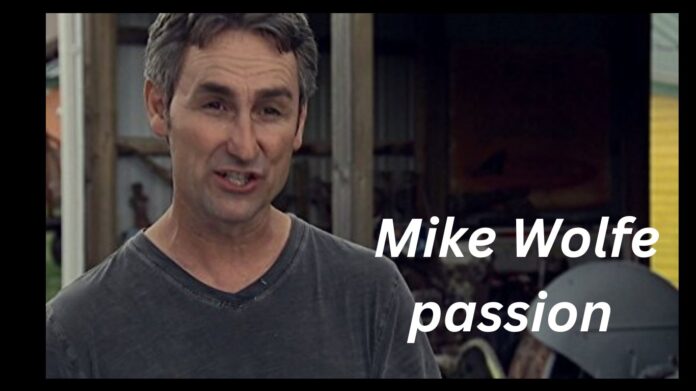You know him as the charming “picker” who can look through a cluttered barn and find treasure that has been kept for decades. The art of the find has been Mike Wolfe’s life’s work and the basis of his TV show American Pickers. But what happens when his “pick” isn’t an old motorbike or a unique neon sign but a whole abandoned building?
In any case, you get a lot more than just another set for a TV show. You get an exciting job.
Wolfe has recently stopped picking fruit on the road and is now focusing on a fixed spot on the map: an old, run-down gas station in downtown Columbia, Tennessee. This is more than just a real estate flip; it’s a deeply personal project that says a lot about his beliefs. That’s not all this project is about; it’s also about bringing the neighborhood back to life. And to be honest, not enough people talk about that side of Mike Wolfe.
What’s Inside the Book
- Finding a Diamond in the Rough: The Find
- After the Show: What Makes a Picker’s Passion Project Go?
- The Goal: From Adorable to Destination
- Why this project is important (and it’s not what you think)
- How one project can bring life back to a town (The Ripple Effect)
Questions People Ask Often
Finding a Diamond in the Rough: The Find
Let’s begin. Imagine a classic gas station from the early 1900s. The building has good bones but a tired spirit, with worn brick, cracked concrete, and that eerie silence that only empty spaces have. It had been sitting there for years in Columbia, a town with a lot of history. A tear-down candidate would be seen by most people as they drive by. But what about Mike Wolfe? He read a story.
One who is a picker sees a story in every layer of peeling paint and every broken bolt. This gas station wasn’t just a building; it was a piece of Americana from a time when people took long road trips across the country and drank soda out of glass bottles. Wolfe has always been brilliant because he can see worth where others only see decay. Here, he’s using the same idea on a huge scale for this project.
He saw more than just a wreck falling apart. Seeing a possible meeting place, he said. He saw places to sit outside and laugh, a fire pit where people could tell stories, and the warm glow of lights bringing a dead area back to life. The promise inside the building was what was found, not the building itself.
After the Show: What Makes a Picker’s Passion Project Go?
Even though American Pickers shows us some of the world of gathering, the show is really about business. Mike and his friends buy low and (sometimes) sell high, and the market keeps going. What drives someone like Wolfe to put all of his time, money, and heart into a project that is, well, stationary?
There is a deeper theme that runs through all of his work that holds the answer: a deep respect for history and workmanship.
It’s something I’ve heard a lot of preservationists and fans agree on. The first thrill is the hunt, when you find something special. But that thrill changes over time. It turns into a matter of care. It’s the strong desire to protect the past and make sure that the art and stories of a different time don’t get lost in the crushing ball of progress.
For Wolfe, this gas stop is the best example of what he means. It’s an important symbol that shouldn’t be sold. This project is his way of giving back, of planting a flag that says, “This place mattered then, and it can matter again now.” It’s a physical representation of his belief that our past is valuable, not just in terms of money, but also in terms of culture and community.
The Goal: From Adorable to Destination
That’s right, he saw it. How do you actually put it into action? You don’t just use a hammer and a dream to fix up an old building. Wolfe worked with a professional building and design company to do this. This was a very important move. It’s the difference between a do-it-yourself job and a real restoration, which keeps the building’s original identity while giving it new life and purpose.
The new area, which has been named “Revival,” is a great example of adaptive reuse. That means the following:
The Shell: The historic front of the gas station and its architectural character were kept. That can’t be changed. You keep what the building is made of.
The Function: The goal has been completely rethought. It used to pump gas, but now it serves food and craft drinks. It’s switching from one type of fuel to another. Isn’t that a smart metaphor?
The atmosphere: Putting chairs outside and a fire pit in the middle is a great idea. It changes a place where people buy things (like a gas stop or restaurant) into a place where people can have experiences. It’s now a place to stay, not just a stop. A place to meet.
Consider it. This project does a few very important things:
It sets a standard: When a famous person carefully spends to preserve history, it gives other investors and business owners faith. It shows that the town is a good place to put your money.
It Makes the Heart Beat: Communities need centers. They need third places—not home or work, but a place where people can get together. The fire pit and seats in “Revival” are meant to make it just that.
Respects Identity: In a world where every strip mall looks the same, keeping historic buildings gives each town its own unique look. Maintaining a sense of place is something that can’t be bought.
Some experts who only look at the bottom line might argue, but this is how I see it: the ROI on a project like this isn’t just revenue. People in the community are proud of it, it’s a tourist attraction, and it helps keep a unique local past alive. That’s worth a lot.
How One Project Can Bring Life Back to a Town (The Ripple Effect)
The most exciting thing about Mike Wolfe’s idea is how it will affect other people. It’s funny how one beautifully fixed-up building makes everything else look better.
Not just an idea; it’s been shown to happen. A single-center project can bring more people on foot, which is good for shops nearby. It might make other property owners want to fix up the outside of their homes and put money into them. It builds pride and interest, which is a good thing. Before you know it, one spark—a fixed-up gas station—has helped give a whole city area new life.
It’s that memory that matters. We need to save more than one building. It’s about using that building as a lighthouse to show everyone the way.
Questions People Often Ask
- Where exactly is Mike Wolfe’s gas station passion project located?
It’s located in downtown Columbia, Tennessee. Columbia is a historic city in Maury County. It is known as the “Antique Capital of Tennessee” because it has so many Antebellum building.
- What is the gas station going to be called?
The renovated space will be called “Revival.” The name is a perfect fit, representing both the revival of the building itself and the revival of community spirit it aims to foster.
- What will ‘Revival’ be? A museum? A store?
It will be a dining and drinking establishment. The plans indicate it will serve food and cocktails, functioning as a community-centric restaurant and bar with ample outdoor seating.
- Is this going to be featured on American Pickers?
While it’s always a possibility, as of now, there has been no official announcement that the restoration will be part of the show. This appears to be a personal venture for Wolfe, separate from the show’s format.
- Why is Mike Wolfe doing this? Doesn’t he just collect old things?
This project demonstrates that his passion extends far beyond collecting. He is deeply committed to historic preservation and community revitalization. Restoring a building is the ultimate form of “picking” – he’s preserving a piece of history for everyone to enjoy.
- When is ‘Revival’ expected to open?
As with any construction project, especially historic renovations, timelines can be fluid. Official opening dates haven’t been widely publicized yet. Your best bet is to follow local Columbia, TN, news sources or Mike Wolfe’s social media for updates.
- Has Mike Wolfe done other projects like this?
Absolutely. Wolfe has been involved in several preservation projects in his hometown of Nashville, Tennessee, including the restoration of several buildings on his own property. This, however, is one of his most significant and public-facing community projects to date.
The Final Word: A Testament to Stewardship
Mike Wolfe’s passion project in Colombia is more than a feel-good story. It’s a masterclass in modern stewardship. It proves that preservation isn’t about living in the past; it’s about using the past to build a more interesting, connected, and vibrant future.
He’s taken the skills honed over a lifetime of picking—seeing value, understanding history, recognizing a good story—and applied them on a grand scale. The result isn’t just a bar named “Revival.” It’s a mission statement. It’s a testament to the idea that the most valuable finds aren’t always the ones that fit in your truck; sometimes, they’re the ones you build a community around.









